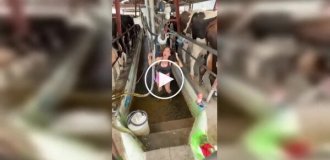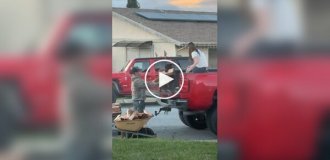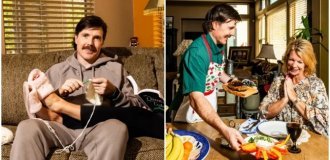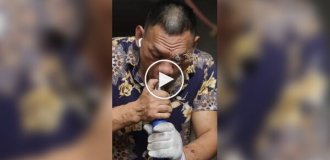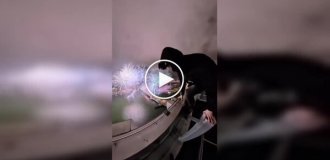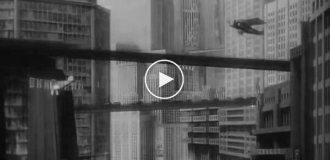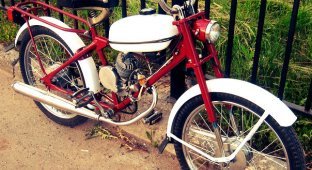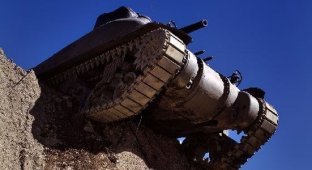Motorcycles in World War II were an independent combat unit. Germany created the first motorcycle battalions back in 1935. Motorcycles were successfully used by both the Red Army and the Allies.

BMW R75



The BMW motorcycle became widespread in the Wehrmacht army. This happened thanks to the R12 and R71 models. But the most famous motorcycle of World War II was the BMW R75, nicknamed “Sahara” due to the fact that it was supplied to Rommel’s army in Africa.
The off-road motorcycle had a four-stroke boxer engine with a volume of 745 cm3 and a power of 26 hp. s., cardan, hydraulic rear brake and nine speeds: seven forward and two reverse. A motorcyclist could stop on the Sahara in the middle of a swamp or sand and move off without slipping.
The downside to the R75's excellence was its price. The motorcycle cost the price of two Volkswagen cars.
The BMW R75 could tow a 37 mm PaK-35/36 anti-tank gun or a trailer with an 81 mm mortar or anti-tank rifle. MG-34 and MG-42 machine guns or a flamethrower were installed on the stroller. On the sidecar and on the motorcycle there were brackets for containers with ammunition, canisters and camouflage nets.
The motorcycle was used in reconnaissance units, in motorcycle rifle units and became one of the symbols of fascist aggression.
DKW



By 1944, Germany began to use lighter motorcycles more. The most popular were DKW RT125 and DKW NZ350.
The 123cc two-stroke DKW RT125 was introduced into service in 1941 and became a masterpiece of engineering. In 1943, a militarized version of the motorcycle was released with a more capacious tank and crankcase cast from cast iron. The engine produced 6.4 hp. and accelerated the motorcycle to 75 km/h.
The DKW NZ350 was produced only for the army. Thanks to the low gear ratios of the gearbox, it easily walked through the mud at low speeds. With a weight of 145 kg and a power of 11.5 liters. With. the motorcycle reached a speed of 105 km/h.
Both models were produced until the end of the war and were so successful that their clones were distributed throughout the world.
Based on the DKW RT125, the Minsk, M1A Moscow and K-125 were developed in the USSR, and the DKW NZ350 became the prototype of the IZH-350.
NSU "Kettenkrad"




This tracked motorcycle went down in history under the name "Kettenkrad" (Kettenkrad - truck, "Kraftrad" - motorcycle), was developed by the inventor Heinrich Ernst Kniepkamp and produced by NSU. The Kettenkrad was equipped with a 1.5-liter Opel Olimpia engine producing 36 hp. With. The motor tractor reached a speed of 65 km/h on the highway and up to 40 km/h on rough terrain.
Initially developed for landing forces operating behind enemy lines, but later began to serve as a tractor. It could pull an artillery piece weighing up to half a ton, or a trailer.
I was engaged in towing aircraft at airfields, laying communication lines - a reel of wire could easily fit behind it.
After the war, surviving specimens were used in agriculture. A total of 9 thousand copies were produced from 1940 to 1949.
Zundapp ks 750




At the end of the 30s, at the Z?ndapp Werke GmbH plant located in Nuremberg, the KS 750 motorcycle was developed and adopted by the Wehrmacht. It was intended for driving on heavy off-road conditions and had increased cross-country ability and maneuverability, and was also used for reconnaissance, transportation of personnel and various cargoes and evacuation of the wounded.
The Zundapp KS 750 motorcycle was equipped with a 751 cc boxer, 2-cylinder, 4-stroke engine. cm, power 26 hp. at 4000 rpm, had a system for adjusting the wheel suspension depending on the condition of the ground, an economical running system without overheating the engine, magneto ignition and a backup gas tank filter, which made it possible to continue driving even if the tank was broken. It could overcome shallow water obstacles with the engine submerged. The motorcycle with sidecar weighed 420 kg, but despite this, it was easy to control and reliable in operation. The motorcycle sidecar had a torsion bar suspension, the wheel drive and brake were from the rear axle of the motorcycle. Bags with ammunition were attached to the left and right of the body, and an installation for a machine gun was installed in the front part.
The Z?ndapp KS 750 motorcycle was intended for European countries, where it was painted dark gray and did not have a single shiny part, and for North African countries, where it was painted dark yellow.
From 1940 to 1944, the Z?ndapp Werke, GmbH plant produced 18,635 motorcycles of the KS 750 model.
"M-72"




The history of the legendary M-72 motorcycle began in 1940. It is known that the motorcycle was copied from the BMW R71. According to one version, the drawings of the motorcycle were handed over to the Soviets by the Germans, according to another, the motorcycles were secretly exported from Germany through third countries. I must admit, we weren’t the only ones who copied BMW. The Americans and even the Japanese were guilty of this.
The M-72 motorcycle was released in the workshops of the Moscow Motorcycle Plant in 1941. “M” meant Moscow. The production was personally approved by Stalin.
The M-72 was equipped with a 746 cm3 opposed lower valve engine with a power of 22 hp. With. and accelerated to 85 km/h. The weight with the stroller was 380 kg. Unfortunately, with Soviet equipment, engineers could not withstand the German precision in manufacturing parts, and the motorcycle was inferior to BMW in reliability.
In the fall of 1941, production was moved to Irbit, Tyumen and Gorky. In Irbit, the production of “M-72” had to be organized in the workshops of the brewery, the remaining places were occupied. Motorcycles were assembled literally in the open air and equipment was installed at the same time.
The first batch of motorcycles was produced in February 1942. During the year, 1,587 motorcycles were produced in Irbit, 1,284 motorcycles in Gorky, and 187 in Tyumen.
In 1943, the production of M-72 increased, and in 1944 it became a record - 5380 units.
In total, during the war years IMZ produced 9,800 motorcycles.
The M-71 sidecar could be equipped with a light or heavy machine gun, a flamethrower, 50- and 82-mm mortars, an anti-tank rifle, and some motorcycles were equipped with armored shields.
The army urgently created reconnaissance groups and motorcycle squads, regiments and brigades. In total, during the war years, at least 49 large motorcycle formations were formed.
A separate special purpose motorized rifle brigade (OMSBON) was formed from employees of the Moscow Motorcycle Plant.
Harley Davidson WLA-42


Soviet machine gunners on a Harley-Davidson WLA-42 motorcycle in one of the settlements in Germany


There weren’t enough of our own motorcycles, and then Lend-Lease came to the rescue. In total, the USSR received 35 thousand motorcycles. 5 thousand of them were sent to the NKVD and the police. The rest go to the front. The Soviet army received American Indianas, English Velocettes and Matchlesses, but the best was the Harley Davidson WLA-42, the supply of which was knocked out by the People's Commissariat of Foreign Trade in 1943.
The motorcycle turned out to be reliable and not picky about fuel. The 740 cc V-shaped longitudinal engine developed a power of 25 hp. s., a high windshield protected from the rain. The motorcycle was equipped with side bags, a holster, footrests and could accelerate to 110 km/h. For his reliability and unpretentiousness, the soldiers nicknamed him “Valuy.”
"Valui" were delivered to the country disassembled; they were assembled by factories in Moscow and Serpukhov. The production of strollers for them was established at GAZ. In 1944, 11,000 strollers were produced, but this was not enough, because more than 14 thousand “Valeuev” strollers alone were brought into the country that year.
In total, during the war years, 90 thousand copies of Harley were produced in the United States. Production of "Valuya" continued until 1951.
